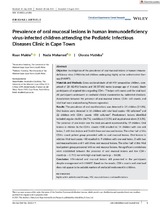| dc.contributor.author | Mulder, Riaan | |
| dc.contributor.author | Mohamed, Nadia | |
| dc.contributor.author | Mathiba, Olorato | |
| dc.date.accessioned | 2021-09-30T19:43:57Z | |
| dc.date.available | 2021-09-30T19:43:57Z | |
| dc.date.issued | 2021 | |
| dc.identifier.citation | Mulder, R. et al. 2021. Prevalence of oral mucosal lesions in human immunodeficiency virus-infected children attending the Pediatric Infectious Diseases Clinic in Cape Town. Clinical and Experimental Dental Research, 1-9. DOI: 10.1002/cre2.484 | en_US |
| dc.identifier.issn | 2057-4347 | |
| dc.identifier.uri | http://doi.org/10.1002/cre2.484 | |
| dc.identifier.uri | http://hdl.handle.net/10566/6849 | |
| dc.description.abstract | Objective: Investigation of the prevalence of oral mucosal lesions in human immuno-deficiency virus (HIV)-infected children undergoing highly active antiretroviral therapy (HAART).Materials and Methods: Cross-sectional study of 66 HIV seropositive children, comprised of 28 (42.4%) females and 38 (57.6%) males (average age of 6 years). Study participants all required data regarding CD4+ T-helper cell counts and the viral load. All participants underwent an orofacial clinical examination by calibrated clinicians. Associations between the presence of oral mucosal lesions, CD4+ cell counts, and viral load were analyzed using Poisson regression. Results: The prevalence of oral manifestations was detected in 21 children (31.8%).Oral lesions were detected in 16 children with viral load copies <50 cells/mm3and22 children with CD4+ counts >500 cells/mm3. Predominant lesions identified included angular cheilitis (36.7%), candidiasis (13.3%) and atypical oral ulcers (13.3%).The presence of one lesion was the most prevalent represented by 19 children. Oral lesions in relation to the CD4+ counts >500 resulted in; 14 children with one oral lesion, 5 with two lesions and 3 with three oral mucosal lesions. The other half of thisCD4+ count patient group presented with no oral mucosal lesions. Oral lesions in relation Viral load copies <50 resulted in; 9 children with one oral lesion, 3 with two oral mucosal lesions and 4 with three oral mucosal lesions. The other half of this Viral load patient group presented with no oral mucosal lesions. No significant correlations were established between the presence of oral mucosal lesions and low CD4+counts (p = 0.715) nor with high viral load counts (p = 0.638).Conclusion: HIV-related oral mucosal lesions still presented in the participants despite management with HAART. Based on the results, CD4+ counts and viral load does not appear to be suitable markers of orofacial involvement in children. | en_US |
| dc.language.iso | en | en_US |
| dc.publisher | Wiley | en_US |
| dc.subject | Paediatric dentistry | en_US |
| dc.subject | Cape Town | en_US |
| dc.subject | South Africa | en_US |
| dc.subject | Dentistry | en_US |
| dc.subject | HIV/AIDS | en_US |
| dc.subject | Children | en_US |
| dc.subject | Human immunodeficiency virus | en_US |
| dc.subject | Oral mucosal lesions | en_US |
| dc.subject | HIV-infected children | en_US |
| dc.subject | Antiretroviral therapy | en_US |
| dc.title | Prevalence of oral mucosal lesions in human immunodeficiency virus-infected children attending the Pediatric Infectious Diseases Clinic in Cape Town | en_US |
| dc.type | Article | en_US |

